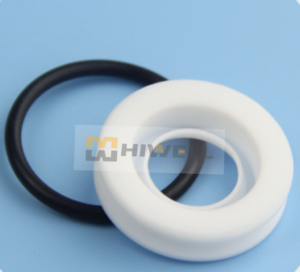Polytetrafluoroethylene (PTFE) possesses numerous excellent properties, such as resistance to strong acids, alkalis, oxidizing agents, solvents, high temperature resistance up to 260 degrees Celsius, low temperature resistance down to -192 degrees Celsius, non-aging, low coefficient of friction, high insulation, etc. While it generally exhibits stable performance, it also has notable drawbacks that limit its range of applications. In the development and utilization of PTFE’s outstanding properties, several defects restrict its usage, and the following are ten of them along with their respective improvement methods:
- Low hardness: PTFE products typically have a low hardness, with a Shore hardness of approximately 55. This limits their ability to withstand high pressure deformation. For instance, when used as gaskets, if tightened too much, they are prone to plastic deformation or cold flow. This indicates poor creep resistance, necessitating modification through the addition of fillers to enhance performance.
- Poor wear resistance: While PTFE products have a very low coefficient of friction, their wear resistance is inadequate when subjected to motion with mating components. They exhibit weak mechanical strength and insufficient rigidity. For example, when used as oil-free lubricating bearings, frequent bearing replacements are required at high speeds, which negatively impacts normal usage. This can be improved by incorporating wear-resistant materials.
- Weak surface wettability: PTFE’s surface energy is low, resulting in its non-stick properties and providing significant benefits in applications involving textiles, adhesives, and fluids. However, it also limits its industrial applications. Surface treatments such as sodium treatment can be employed to promote bonding with other materials.
- Limitations in processing methods: PTFE resin primarily relies on molding for production. The poor flowability of resin powder necessitates the use of molding and extrusion processes for manufacturing many components, followed by precision machining. PTFE melt exhibits high viscosity, even at temperatures close to its melting point or decomposition temperature, preventing it from flowing and being processed using the same methods as thermoplastic materials. Almost every component of a specific specification requires a dedicated set of molds, increasing processing costs. Moreover, PTFE processing is complex, which limits its application scope.
- High thermal expansion coefficient: PTFE exhibits significant and irregular changes in linear expansion coefficient with temperature variations, leading to poor dimensional stability during cooling and heating. Objects sintered, cooled, or machined on a lathe using PTFE are still susceptible to noticeable changes with environmental temperature fluctuations. This is not solely due to internal stress but also the result of an excessively large linear expansion coefficient. For instance, when used as a lining material in anti-corrosion equipment, the mismatch in linear expansion coefficient between PTFE and the metal shell can cause deformation, delamination, or internal collapse of the PTFE lining under fluid temperature changes and negative pressure operation conditions. Hence, pure PTFE is not suitable for precision components.
- Toxic gas release at high temperatures: Although PTFE is generally a safe and non-toxic product, it releases highly toxic ions when heated to temperatures above 380 degrees Celsius. Therefore, precautions should be taken during operations involving open flames, welding, or high-temperature heating, ensuring proper ventilation and safety measures.
- Electrostatic properties: While PTFE exhibits excellent electrical characteristics, including the lowest dielectric constant, dissipation factor, and maximum values for volume and surface resistivity among solid materials, it inherently possesses high static charges due to the sintering process used in its production. This limits its use in many scenarios. To address this, anti-static materials can be incorporated to create anti-static products.
- Dimensional stability during molding: PTFE components produced by molding exhibit high pressure and good compactness, resulting in high density and minimal sintering shrinkage. If the pressure is too light, significant shrinkage occurs during cooling, and it is irregular in nature. PTFE components require larger tolerance ranges and cannot be precision machined like iron. Its thermal expansion is ten times greater than that of iron. Many people use tolerance specifications based on steel parts, which can lead to deviations from tolerance ranges after actual processing due to cooling shrinkage or thermal changes. Even directly molded and sintered PTFE plates have relatively large tolerances. For example, when processing PTFE plates with a thickness of 10mm, the thickness tolerance according to industry standards is (+1.00, -0.50).
- Bonding and welding difficulties: PTFE exhibits inertness, making it non-adhesive to most substances. However, bonding or welding issues often arise during usage. Bonding methods include discharge treatment and alkali metal solution treatment, enabling adhesion between PTFE components and other materials. The discharge method involves placing PTFE components in a plasma generator or glow discharge tube, evacuating them, introducing a small amountof oxygen or air, and applying high-frequency discharge or glow discharge to modify the surface. Alkali metal solution treatment involves immersing PTFE components in an alkali metal solution, such as a sodium solution, to alter the surface properties and promote bonding.
- Limited color options: PTFE products are typically available in white or off-white colors, which may not be suitable for certain aesthetic or branding requirements. However, various methods can be employed to introduce color pigments into PTFE, such as melt blending or surface coating techniques, to achieve desired color effects.
Conclusion:
Polytetrafluoroethylene (PTFE) exhibits outstanding properties, including water and oil repellency, high temperature stability, low temperature non-brittleness, resistance to aging and flame, making it suitable for applications in highly corrosive pipelines, containers, pumps, valves, as well as specialized fields such as radar, high-frequency communication equipment, and high-insulation electrical, electronic, and aerospace industries. However, despite its exceptional performance, PTFE still has several deficiencies that need to be addressed for its widespread use in various working environments.
As we continue to harness the high-performance aspects of PTFE and develop applications for PTFE products, it is important to acknowledge its shortcomings and explore ways to improve its defects, thus expanding the application potential of polytetrafluoroethylene.


